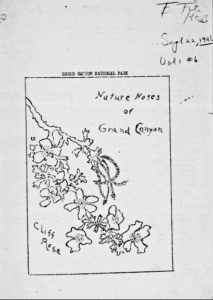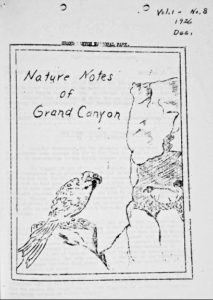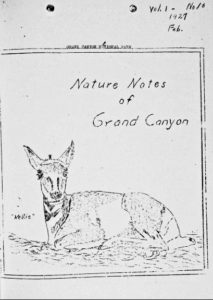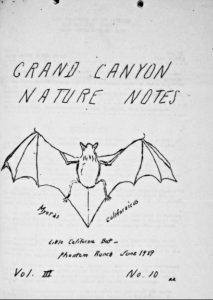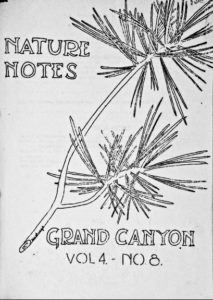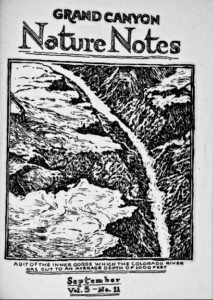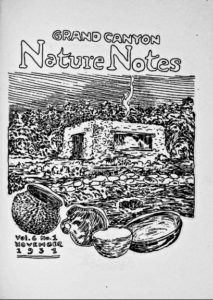Grand Canyon began issuing the bulletin Nature Notes in 1926, the purpose of which was “giving information to those interested in the natural history and scientific features of the Grand Canyon National Park.”
Ranger Naturalist Glen E. Sturdevant served as editor and primary contributor to Nature Notes until his death in February, 1929 (see Volume 3, No. 8), after which Edwin D. McKee took over, serving both as editor and new Park Naturalist. The bulletin was issued monthly by the park until 1931, when the Grand Canyon Natural History Association took over the publications, which continued until 1935. Below are PDF versions of Volume 1, No. 1 through Volume 6, No. 5. Later editions can be found on the Grand Canyon National Park Website here (page opens in new window).
Volume 1, No. 1 – March, 1926
Kaibab Squirrel (Sciurus kaibabensis), Abert Squirrel (Sciurus aberti), by Glen E. Sturdevant
Utah Juniper (Juniperus utahensis), by Glen E. Sturdevant
Suicide Robin Returns
Volume 1, No. 2 – April, 1926
Educational Plans, by E.T. Scoyen
Western Yellow Pine (Pinus ponderosa), by G.E. Sturdevant
Water Ouzel (Cinclus mexicanis), by G.E. Sturdevant
Volume 1, No. 3 – May, 1926
Pinon Pine (Pinus edulis), by Glen E. Sturdevant
Ancient Ferns, by Glen E. Sturdevant
Long-crested Jay (Cyanocitta stelleri diademata), by Glen E. Sturdevant
Any Port in a Storm
Volume 1, No. 4 – June, 1926
Fossil Footprints, by Dr. C.W. Gilmore, Curator of Vert. Paleontology, U.S. National Museum
Dragon Fly, by G.E. Sturdevant
Mescal (Agave utahensis), by G.E. Sturdevant
Daily Battles, by G.E. Sturdevant
Volume 1, No. 5 – August, 1926
American Beaver (Castor canadensis mexicanus), by G.E. Sturdevant
Intelligent Robin
Courtin’ Time, by G.E. Sturdevant
A Few Pets, by E.T. Scoyen
Volume 1, No. 6 – September, 1926
Cliff Rose (Cowania stansburiana), by G.E. Sturdevant
Button, Button, Who has the Button?
Salt in the Tapeats Sandstone, by G.E. Sturdevant
Kaibab Deer Arrives on South Rim, by E.T. Scoyen
Volume 1, No. 7 – November, 1926
The Common Skunk (Mephitis mephitis), by Glen E. Sturdevant
Fossil Fish
Autumn
Publications Received for Reference Library
Volume 1, No. 8 – December, 1926
The Turkey Buzzard (Cathartes aura), by G.E. Sturdevant
Cats Claw (Acacia greggii), by G.E. Sturdevant
Calcite, by G.E. Sturdevant
Bear?, by G.E. Sturdevant
Volume 1, No. 9 – January, 1927
Fossils, by G.E. Sturdevant
Conservation, by G.E. Sturdevant
Volume 1, No. 10 – February, 1927
An Experimental Repair Job, by E.T. Scoyen
You’re Next: Mr. Duck, by E.T. Scoyen
Volume 1, No. 11 – March, 1927
A Winter Resident, by G.E. Sturdevant
Wild Goose, by G.E. Sturdevant
Theories Relating to Origin of the Canyon, by G.E. Sturdevant
Ranger Smith Entertains
Volume 1, No. 12 – May, 1927
Flora of the Tonto Platform
Antelope Happenings
Mountain Sheep Visits Studio
Arizona Red-bud
Volume 2, No. 1 – June, 1927
Navajo Makes Rain
Fox Holds Up Party
When Insects Were the Size of Birds
Grand Canyon Visited by Leading Geologists
Trailside Notes, by Edwin McKee
*Note – Text is difficult to read due to the condition of the original copy.
Volume 2, No. 2 – July, 1927
The Papilio Tribe of Butterflies, by Edwin D. McKee
Formations Exposed at the Grand Canyon, by G.E. Sturdevant
*Note – Text is difficult to read due to the condition of the original copy.
Volume 2, No. 3 – August, 1927
Cats and Polecats
Birds of the Havasupai Canyon, by Edwin D. McKee
Canyon Rim Roses, by G.E. Sturdevant
“Pal”
Volume 2, No. 4 – September, 1927
Crossbill, by Mrs. G.E. Sturdevant
Pinon Nuts, by G.E. Sturdevant
Mother Grouse Poses for Movie Camera
Pegmatite Dikes
Grand Canyon Animal Tracks
Volume 2, No. 5 – October, 1927
Tame Deer Herd Started at Grand Canyon
Canyon Hiking
Pet Fawn Introduced to Snow and Rain
A Canyon Culprit
Volume 2, No. 6 – November, 1927
Breaking a Trail Through Bright Angel Canyon, by F.E. Matthes, U.S. Geological Survey
Volume 2, No. 7 – December, 1927
Pal Killed by Mountain Lion
Canyon Walls are Barrier to Migration
Antelope Reveal Goat Traits
“Smoky” is an Apt Pupil
Mountain Sheep Observed on Canyon Rim
Crossbill Winters at Grand Canyon, by Mrs. G.E. Sturdevant
Volume 2, No. 8 – January, 1928
Nesting and Food Habits of the Abert Squirrel at Grand Canyon
Species of Productus of the Kaibab Limestone at Grand Canyon
Volume 2, No. 9 – February, 1928
A Visit to an Un-frequented Part of the Grand Canyon
A Near Tragedy
*Note – Text is difficult to read due to the condition of the original copy.
Volume 2, No. 10 – March, 1928
Springtime at the Grand Canyon
Champion barker?
Rejuvenation
Mountain Sheep Leads Way Up the Trail
Third Publication on Grand Canyon Animal Tracks
Deer Leaps 1700 Feet to Death
*Note – Text is difficult to read due to the condition of the original copy.
Volume 2, No. 11 – April, 1928
Inspecting a Possible Trout Stream of Grand Canyon
Volume 2, No. 12 – May, 1928
Red-shafted Flicker Nests on Canyon Rim
Hermit Steer of the Canyon
Deer Arrive at Bright Angel Point
Sea Gull Visits the Park
Kaibab Squirrel Plentiful
Results if a Large Crop of Pinon Nuts
Lading of Colorado River
Volume 3, No. 1 – June, 1928
Antelope for Burros
Cassin Vireo Observed
Kaibab Fawn Captured
Bird Life on the Tonto Platform, by Edwin D. McKee
Cougars Not Extinct on Kaibab, by Chas. W. Merriam
Fossils Collected
Mountain Sheep Comes up Bright Angel Trail
Volume 3, No. 2 – July, 1928
Saturn as a Brilliant Object in the Southern Sky, by M.R. Tillotson
Grand Canyon Illuminated by Aurora Borealis, by M.R. Tillotson
Ironwood (Knowlton’s Hornbeam), by G.E. Sturdevant
Analogy of Past and Present Life, by Chas. W. Merriam
The Polyphemus Moth, by Edwin D. McKee
Dusky Grouse on South Rim
Volume 3, No. 3 – August, 1928
Stubby
New Bird Records for Park, by Edwin D. McKee
The Geaster or Earth Star, by H.V. Hibbard
The Blue-Bellied Lizard, by Edwin D. McKee
Oswald, by Mrs. G.E. Sturdevant
Volume 3, No. 4 – September, 1928
What Causes the Canyon Walls to Recede?, by G.E. Sturdevant
Five Planets in the Autumn Skies, by M.R. Tillotson
Bird Baths, by Mrs. G.E. Sturdevant
Volume 3, No. 5 – October, 1928
Lessons from a Graveyard
Kingfisher at Grand Canyon
Two Trail Parties in One Picture
Robin Breaks Ice to Take Bath
Antlers as an Age Indicator of Deer
Ring-tailed Cats, by Mrs. G.E. Sturdevant
Volume 3, No. 6 – December, 1928
A Reconnaissance of the Northeastern Part of Grand Canyon National Park
Volume 3, No. 7 – January, 1929
Additional Indian Ruins of Clear Creek Region, by A.L. Brown
Lessons from the Grand Canyon, by G.E. Sturdevant
Clear Creek is Stocked with Trout
In Time for Refreshments
Obituary: Prof. H.V. Hibbard
Volume 3, No. 8 – February, 1929
Our Sorrow, by M.R. Tillotson
Obituary: Glen Ernest Sturdevant
Obituary: Fred Johnson
Fawns Arrive from Kaibab, by G.E. Sturdevant
Beaver at Phantom Ranch, by G.E. Sturdevant
Favorable Snow Conditions
Volume 3, No. 9 – May, 1929
Scientific Work Conducted at Grand Canyon
The Chuckwalla, by Miss Barbara Hastings
Life Zones of the Grand Canyon, by Vernon Baily, Bureau of Biological Survey, U.S. Department of Agriculture
Wind Erosion in the Grand Canyon
Odds and Ends
Volume 3, No. 10 – June, 1929
Scientific Work
Manzanita on the South Rim, by Earl W. Count
Lady Hecate, by Barbara Hastings
Nesting Notes (extracts from the records of Mrs. F.M. Bailey and the park Naturalist)
The Coronado Expedition, by Stephen B. Jones
Soil of the South Rim – A Query, by Earl W. Count
Heralds of Summer
Volume 3, No. 11 – July, 1929
A Food Plant of the Indians, by Miss Barbara Hastings
The Path of a Thunderstorm, by Stephen B. Jones
Lunch à la Abert, by Ranger Naturalist Count
The Horned Owl, by the Park Naturalist
Yavapai Catches a Bolt, by Earl W. Count
Summer Snowstorms, by S.B. Jones
Facts – Not Fancies
Volume 3, No. 12 – August, 1929
The Mariposa Lily, by Miss Laura Mills
Deer Conditions on the Kaibab up to August 5, 1929, by Vernon Bailey, US Biological Survey
Laoporus Goes Walking, by the Park Naturalist
Cricket Notes, by E.W. Count
Lightning-scarred Trees, by S.B. Jones
The Next Generation, by the Park Naturalist
Volume 4, No. 1 – September, 1929
Horned Toads, by S.B. Jones
The Gathering of the Jay Clan (Cyanocephalus cyanocephalus), by E.W. Count
Mushrooms on the Kaibab, by Miss Laura E. Mills
Snakes as Mediators, by the Park Naturalist
A Mutating Penstemon, by E.W. Count
Along the Trails, by the Park Naturalist
The Yavapai Station
Volume 4, No. 2 – October, 1929
The Cover (Hopi Symbols), by E.W. Count
Flying Deer, by P.P. Patraw
Surface Topography of the Kaibab, by the Park Naturalist
The Elusive Sceloporus, by S.B. Jones
Hither and Yon, by the Park Naturalist
Volume 4, No. 3 – November, 1929
Feathered Friends, by the Park Naturalist
Middle Canyon Sculpturing, by Dr. W.M. Davis, formerly of Harvard University
Avian Cliff Dwellers, by E.W. Count
“Porky,” by S.B. Jones
The Bright Angel Fault, by the Park Naturalist
Volume 4, No. 4 – December, 1929
The Cougar of the South Rim, by H.R. Lauzon
The Flora of the Hermit Shale in Grand Canyon, by Dr. David White, US Geological Survey
Unconventional Pines, by S.B. Jones
Rug-weaving, Navajo Style, by E.W. Count
Grand Canyon Lichens, by the Park Naturalist
Volume 4, No. 5 – March, 1930
Yavapai Observation Station, by P.P. Patraw
A Grand Canyon Cliff Ruin, by E.W. Count
A Unique Combination, by J.P. Brooks
Climbing Deer, by S.B. Jones
Pinyon Puzzle, by E.W. Count
Winter Robins
The Youthful Grand Canyon, by the Park Naturalist
Volume 4, No. 6 – April, 1930
Lizards as Known to the Indians, by E.W. Count
Briefs, by the Park Naturalist
Our Cactuses, by Miss Pauline Mead, Univ. of Chicago
The Grand Canyon Rattlesnake, by the Park Naturalist
Volume 4, No. 7 – May, 1930
Scientific Expedition to the Nankoweap, by the Superintendent’s Office
The Reference Library, by the Park Naturalist
Oh Cedar!, by S.B. Jones
Wild Burros of the Grand Canyon, by P.P. Patraw
The Navajo Silversmith, by E.W. Count
Pages in Cambrian History, by the Park Naturalist
Left Overs
Volume 4, No. 8 – June, 1930
Report of Nankoweap Trip, by C.E. Resser, Curator US Natl. Museum
Wayside Museum of Archaeology Expedition, by Harold S. Gladwin, Director of Gila Pueblo, Arizona
Vanadinite in the Grand Canyon, by the Park Naturalist
The Kaibab Trail, by E.W. Count
Odds and Ends
Volume 4, No. 9 – July, 1930
A Living Conquest, by E.W. Count
Fossils & What they Tell, by R.L. Nichols
Copper Deposits of Grand Canyon, by the Park Naturalist
July Bird Notes
Volume 4, No. 10 – August, 1930
Hopi Snake Dance, by Barbara H. McKee
Clear Creek Expedition, by Russell Hastings
Chizel-teeth Chatter, by E.W. Count
An Archaeological Find, by Arthur Soper
irregularities in Climatic Belts, by Clyde Searl
Odds and Ends, by the Naturalist Staff
Volume 4, No. 11 – September, 1930
Some Grand Canyon Plants and Their Uses, by Pauline Mead
The Carrying Power of the Colorado River, by R.L. Nichols
Dining Solitaire, by E.W. Count
The Esplanade, by E.D. McKee
A New Bird Record, by Clyde Searl
The Canyon Towhee, by the Park Naturalist
Volume 4, No. 12 – October, 1930
Deer Antlers, by Clyde Searl
Butterflies of the Grand Canyon, by Robert G. Wind, Berkeley, Cal.
Seeds of Some Grand Canyon Flowers, by Pauline Mead
Briefs, by E.W. Count
Ripples in the Sands of Time, by E.D. McKee
Volume 5, No. 1 – November, 1930
The Story of a Pebble, by Clyde Searl
Butterflies near the Colorado River in November, by Pauline Mead
Geological and Wild Life Observations between Bass Canyon and Hermit Canyon, by E.D. McKee
A Winter Blooming Goosefoot, by Pauline Mead
Briefs
Volume 5, No. 2 – December, 1930
Small but Mighty, by E.D. McKee
A Brief Ecological Comparison of Life Zones on the Kaibab Plateay, by Pauline Mead
Fossil Mountain, by E.D. McKee
Preliminary Report on the Germination of Native Wild Flower Seeds, by Pauline Mead
Volume 5, No. 3 – January, 1931
The Explorer, by M.R. Tillotson
Beetles, by Clyde C. Searl
The Origin of Hermit Basin, by Edwin D. McKee
Second Report of the Germination of Native Wild Flower Seeds, by Pauline Mead
The Badger and Its Environment, by Chester Markeley
The Goal of Yavapai, by Clyde C. Searl
Volume 5, No. 4 – February, 1931
Planting Fish Eggs in Clear Creek, by P.P. Patraw
The First Spring Flower, by Pauline Mead
Some Interesting Bird Records, by Clyde C. Searl
A Strange Combination, by Burt Luzen
A Remnant of the Age of Fishes, by Edwin McKee
Building Rocks, by Clyde C. Searl
Third Report on the Germination of Native Wild Flower Seeds, by Pauline Mead
Volume 5, No. 5 – March, 1931
Fossil Footprints of the Coconino, by Edwin D. McKee
Sedimentary Rocks, by Clyde C. Searl
The Rock Loving Alum Root, by Pauline Mead
Official Report on Stocking Canyon Streams with Fish, by J.P. Brooks
The Raccoon of Havasupai, by Chester R. Markley
Fourth Report on the Germination of Native Wild Flower Seeds, by Pauline Mead
Volume 5, No. 6 – April, 1931
Some Beetles of Grand Canyon, by Clyde C. Searl
A Lively Little Beggar, by Barbara H. McKee
Pocket Mice!, by Edwin D. McKee
Early Stages in the Development of Rainbow Trout, by Chester R. Markley
Notelets
Volume 5, No. 7 – May, 1931
Geography of the Middle Cambrian Period, by Edwin D. McKee
An Interesting Bug, by Clyde C. Searl
Broom-rape, A Root Parasite, by Pauline Mead Patraw
Winter Feeding of White-tailed Squirrels, by George Collins
Field Observations, by the Naturalist Staff
Volume 5, No. 8 – June, 1931
Where Our Cacti Grow, by Pauline Mead Patraw
Bare Facts about Bear Tracks, by George Collins
Birding in Grand Canyon, by Randolph Jenks, Curator of Ornithology, Museum of Northern Arizona
Sonora Beaver, by Chester Markley
A Mother Squirrel Transports its Young, by R.A. Redburn
Field Observations, by the Naturalist Staff
Volume 5, No. 9 – July, 1931
Bats, by Carol F. Tyler
Relics of the Past, by Antone Albert, Gardner, El Tovar Hotel
How the Supai Indians Prepare Mescal As Told Me by Supai Lilly Burro, by Barbara H. McKee
A Gopher Snake Lunches, by Earl W. Count
Giant Moths, by Edwin D. McKee
Volume 5, No. 10 – August, 1931
Blue Ribbon Minerals, by H.H. Waesche
The Blue Haze of Grand Canyon, by Ralph A. Redburn, with suggestions and additions by Prof. Henry Norris Russell, Princeton University
Some Birds and Their Nests on the Kaibab, by Randolph Jenks, Curator of Ornithology, Museum of Northern Arizona
Trees Gripping the Hillside, by E.W. Count
Grand Canyon – A Barrier to Reptiles?, by Edwin D. McKee
Volume 5, No. 11 – September, 1931
The Colorado River, by R.A. Redburn
Two Reptiles New to the Grand Canyon, by Charles M. Bogart, Los Angeles Society of Natural History
A Quarrel among Bird Families, by Edwin D. McKee
Forest Fire (A Poem), by Ciwa Lynch of Tempe, Arizona
Volume 5, No. 12 – October, 1931
A Trip Down Tanner Trail, by Vernon Bailey, U.S. Biological Survey
Additional Notes on the Tanner Trail Trip, by Edwin D. McKee
An Historical Record, by Godfrey Sykes, Desert Laboratory, Tucson, Arizona
Pinyon Pine Nuts, by Ralph A. Redburn
Crinoidal Limestone, by Edwin D. McKee
Volume 6, No. 1 – November, 1931
An Archaeological Exhibit, by Edwin D. McKee
Early November Bird Reports, by Clyde Searl
Plant Succession in Kaibab Limestone, by Pauline Mead Patraw
An Experiment in Grand Canyon with the American Pronghorn, by Ralph A. Redburn
Miscellany
Volume 6, No. 2 – December, 1931
Dragon-flies at Grand Canyon, by Clyde C. Searl
Russian Thistle, by Earl W. Count
The Origin of Bright Angel Canyon, by Edwin D. McKee
Miscellany
Volume 6, No. 3 – January, 1932
The Yucca ~ Swordlike Yet Friendly, by Barbara H. McKee
Navi’-Pe, by Earl W. Count
A Deeper Canyon, by Clyde C. Searl
When Winter Comes, by Edwin D. McKee
Special Notes
Chipmunk (A Poem), by Ciwa Lynch of Tempe, Arizona
Volume 6, No. 4 – February, 1932
Greenland Lake, by Edwin D. McKee
The Herbarium of Grand Canyon National Park, by Clyde C. Searl
Field Observations, by the Staff
Comparative Porosity of Rock Formations in Grand Canyon, by Hugh H. Waesche
Personnel Notes
Volume 6, No. 5 – March, 1932
Spring is Near, by Donald Edward McHenry
Vandals of the Sand, by Clyde C. Searl
The Ancient Mazatzal Land, by Edwin D. McKee
Identification of the Common Pink Mineral found near Phantom Ranch, by B.F. Moomaw, Jr., Virginia Polytechnic Institute
Field Observations






